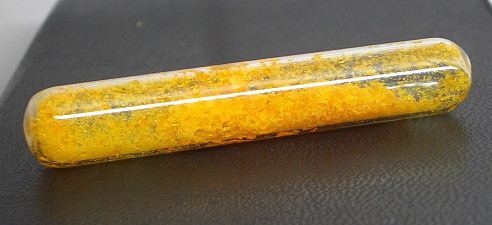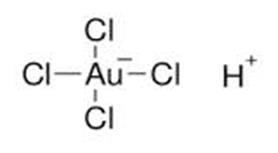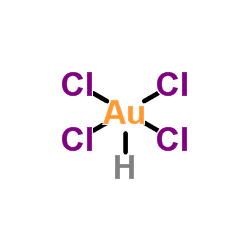Molar mass 339.785 g/mol Melting point 254 °C | Formula HAuCl4 Density 3.9 g/cm³ | |
 | ||
Appearance orange-yellow needle-like crystals; hygroscopic | ||
Make gold from chloroauric acid
Chloroauric acid is an inorganic compound with the chemical formula HAuCl
4. Both the trihydrate and tetrahydrate are known. It is an orange-yellow solid, a common precursor to other gold compounds and an intermediate in the purification of gold metal. Both the trihydrate and tetrahydrate are available commercially.
Contents
- Make gold from chloroauric acid
- Gold aqua regia dissolving chloroauric acid gold refining recovery pure gold precipitate
- Acidity
- Structure
- Solute properties
- Chemical reactions
- Production
- Uses
- Health effects and safety
- References

Gold aqua regia dissolving chloroauric acid gold refining recovery pure gold precipitate
Acidity
Chloroauric acid is a strong monoprotic acid.
Structure

The crystalline tetrahydrate is known to contain H
5O+
2·AuCl−
4 and two water molecules. The AuCl−
4 anion has square planar molecular geometry. The Au–Cl distances are around 2.28 Å. Other d8 complexes adopt similar structures, e.g. [PtCl4]2−.
Solute properties

Solid chloroauric acid is a hydrophilic (ionic) protic solute. It is soluble not only in water, but also in many oxygen-containing solvents, such as alcohols, esters, ethers, and ketones. For example, in dry dibutyl ether of diethylene glycol, the solubility exceeds 1 mol/L. Saturated solutions in the organic solvents often are the liquid solvates of specific stoichiometry.
When heated in air, solid HAuCl4·nH2O melts in the water of crystallization, quickly darkens and becomes dark brown.
Chemical reactions

Upon treating chloroauric acid with a standard base, it converts to metal, tetrachloridoaurate and water. The related thallium salt is poorly soluble in all nonreacting solvents. Salts of quaternary ammonium cations are known. Other complex salts include [Au(bipy)Cl2][AuCl4] and [Co(NH3)6][AuCl4]Cl2.
Gold nanostructures can be made from chloroauric acid in a two-phase redox reaction whereby metallic clusters are amassed through the simultaneous attachment of self-assembled thiol monolayers on the growing nuclei. AuCl−
4 is transferred from aqueous solution to toluene using tetraoctylammonium bromide where it is then reduced with aqueous sodium borohydride in the presence of a thiol.
Partial reduction of chloroauric acid gives oxonium dichloridoaurate(1−). Reduction may also yield other gold(I) complexes, especially with organic ligands. Often the ligand serves as reducing agent as illustrated with thiourea, (H2N)2CS:
AuCl−4 + 4 (H
2N)
2CS + H
2O → Au[(H
2N)
2CS]+
2 + (H
2N)
2CO + S + 2 Cl−
+ 2 HCl
Chloroauric acid is the precursor to gold nanoparticles by precipitation onto mineral supports. Heating of HAuCl4·nH2O in a stream of chlorine gives gold(III) chloride (Au2Cl6).
Production
Chloroauric acid is produced by dissolving gold in aqua regia (a mixture of concentrated nitric and hydrochloric acids) followed by careful evaporation of the solution:
Au + HNO3 + 4 HCl → HAuCl4 + NO + 2 H2OUnder some conditions, oxygen can be used as the oxidant. For higher efficiency, these processes are conducted in autoclaves, which allows greater control of temperature and pressure. Alternatively, a solution of HAuCl4 can be produced by electrolysis of gold metal in hydrochloric acid:
2 Au + 8 HCl → 2 HAuCl4 + 3H2To prevent the deposition of gold on the cathode, the electrolysis is carried out in a cell equipped with a membrane. This method is used for refining gold. Some gold remains in solution in the form of [AuCl2]−.
A solution of HAuCl4 can also be obtained by the action of chlorine or chlorine water on metallic gold in hydrochloric acid:
2 Au + 3 Cl2 + 2 HCl → 2 HAuCl4This reaction is widely used for extracting gold from electronic and other "rich" materials.
In addition to the above routes, many other ways exist to dissolve gold, differing in the choice of the oxidant (hydrogen peroxide, hypochlorites) or variations of conditions. It is possible also to convert the trichloride (Au2Cl6) or the oxide (Au2O3·nH2O).
Uses
Chloroauric acid is the precursor used in the purification of gold by electrolysis.
Liquid–liquid extraction of chloroauric acid is used for the recovery, concentrating, purification, and analytical determinations of gold. Of great importance is the extraction of HAuCl4 from hydrochloric medium by oxygen-containing extractants, such as alcohols, ketones, ethers and esters. The concentration of gold(III) in the extracts may exceed 1 mol/L. The most frequently used extractants for this purpose are dibutyl glycol, methyl isobutyl ketone, tributyl phosphate, dichlorodiethyl ether (chlorex).
In histology, chlorauric acid is known as "brown gold chloride", and its sodium salt NaAuCl4 as "gold chloride", "sodium gold chloride" or "yellow gold chloride". The sodium salt is used in a process called "toning" to improve the optical definition of tissue sections stained with silver.
Health effects and safety
Chloroauric acid is a strong eye, skin, and mucous membrane irritant. Prolonged skin contact with chloroauric acid may result in tissue destruction. Concentrated chloroauric acid is corrosive to skin and must, therefore, be handled with appropriate care, since it can cause skin burns, permanent eye damage, and irritation to mucous membranes. Gloves are worn when handling the compound.
